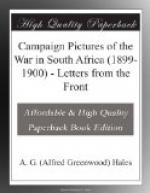We had drifted a few hundred yards behind the advance party, but were a good distance in front of the rearguard, when a number of horsemen made a dash from the kopjes which we were skirting, and the rifles began to speak. There was no time for poetry; it was a case of “sit tight and ride hard,” or surrender and be made prisoners. Lambie shouted to me: “Let’s make a dash, Hales,” and we made it. The Boers were very close to us before we knew anything concerning their presence. Some of them were behind us, and some extended along the edge of the kopjes by which we had to pass to get to the British line in front, all of them were galloping in on us, shooting as they rode, and shouting to us to surrender, and, had we been wise men, we would have thrown up our hands, for it was almost hopeless to try and ride through the rain of lead that whistled around us. It was no wonder we were hit; the wonder to me is that we were not filled with lead, for some of the bullets came so close to me that I think I should know them again if I met them in a shop-window. We were racing by this time, Lambie’s big chestnut mare had gained a length on my little veldt pony, and we were not more than a hundred yards away from the Mauser rifles that had closed in on us from the kopjes. A voice called in good English: “Throw up your hands, you d—— fools.” But the galloping fever was on us both, and we only crouched lower on our horses’ backs, and rode all the harder, for even a barn-yard fowl loves liberty.
All at once I saw my comrade throw his hands up with a spasmodic gesture. He rose in his stirrups, and fairly bounded high out of his saddle, and as he spun round in the air I saw the red blood on the white face, and I knew that death had come to him sudden and sharp. Again the rifles spoke, and the lead was closer to me than ever a friend sticks in time of trouble, and I knew in my heart that the next few strides would settle things. The black pony was galloping gamely under my weight. Would he carry me safely out of that line of fire, or would he fail me? Suddenly something touched me on the right temple; it was not like a blow; it was not a shock; for half a second I was conscious. I knew I was hit; knew that the reins had fallen from my nerveless hands, knew that I was lying down upon my horse’s back, with my head hanging below his throat. Then all the world went out in one mad whirl. Earth and heaven seemed to meet as if by magic. My horse seemed to rise with me, not to fall, and then—chaos.
When next I knew I was still on this planet I found myself in the saddle again, riding between two Boers, who were supporting me in the saddle as I swayed from side to side. There was a halt; a man with a kindly face took my head in the hollow of his arm, whilst another poured water down my throat. Then they carried me to a shady spot beneath some shrubbery, and laid me gently down. One man bent over me and washed the blood that had dried on my face, and then carefully bound up my wounded temple. I began to see things more plainly—a blue sky above me; a group of rough, hardy men, all armed with rifles, around me. I saw that I was a prisoner, and when I tried to move I soon knew I was damaged.




